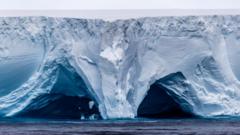Experts warn that the arrival of A23a, a massive ice structure with a history dating back to 1986, poses a serious risk to the biodiversity of the region. Icebergs like A23a can disrupt feeding patterns and habitats, further jeopardizing vulnerable species.
Giant Iceberg Threatens Wildlife as It Approaches South Georgia Island

Giant Iceberg Threatens Wildlife as It Approaches South Georgia Island
A colossal iceberg, A23a, drifts towards South Georgia, raising concerns for local penguins and seals as it nears potential grounding.
In a worrying development for wildlife in the South Atlantic, the world's largest iceberg, known as A23a, is on a collision course with South Georgia, a crucial habitat for penguins and seals. Currently 173 miles (280 km) away, A23a is making its way from Antarctica towards the British territory, where it poses a serious threat of grounding and breaking apart upon contact.
Past incidents have revealed the grave dangers icebergs present to marine wildlife. Significant casualties among birds and seals occurred during prior close encounters, highlighting the peril that looms. "Icebergs are inherently dangerous. I would be extraordinarily happy if it just completely missed us," commented Simon Wallace, a sea captain aboard the South Georgia government vessel Pharos.
Recently, a Royal Air Force reconnaissance flight observed A23a in its approach. Scientists, sailors, and fishermen globally are closely monitoring satellite images to track the iceberg’s movements. A23a, one of the oldest icebergs in existence, detached from the Filchner Ice Shelf in Antarctica in 1986 but was caught in a seafloor trap until it finally broke free last December. Its journey is marked by melting under warmer waters, reducing its size from a staggering 3,900 sq km to about 3,500 sq km—an area comparable to Cornwall.
Moreover, the iceberg's towering cliffs, reaching 1,312 ft (400 m), are steadily eroding, with large ice chunks breaking off into nearby waters. Icebergs have previously caused havoc for wildlife in South Georgia, as evidenced by the 2004 grounding of iceberg A38, which led to the death of numerous penguin chicks and seal pups.
Mark Belchier, a marine ecologist connected with the South Georgia government, states, "South Georgia sits in iceberg alley, so impacts are to be expected for both fisheries and wildlife, and both have a great capacity to adapt." Nevertheless, sailors and fishermen express growing concern over the increasing frequency and size of icebergs in the region.
In 2023, iceberg A76 posed a significant threat, creating treacherous conditions for fishing operations. "Those pieces basically cover the island - we have to work our way through it," noted Andrew Newman from Argos Froyanes, a fishing company. The changing environment—marked by glacial retreat and fluctuating sea ice levels—has made navigating these waters more challenging, as Simon Wallace described the precarious nature of working near icebergs.
While A23a might not have been directly influenced by climate change (having calved long before the current warming trends), its presence and those of other icebergs signal a worrying future for Antarctic ecosystems, as warmer temperatures lead to more ice fragments breaking away.
Interestingly, A23a’s advance has presented a rare scientific opportunity. A team from the British Antarctic Survey, aboard the Sir David Attenborough vessel, successfully collected water samples near A23a earlier this year, providing insight into how mega icebergs impact marine environments. Researcher Laura Taylor emphasized that the melting iceberg releases nutrients and chemicals into the water, affecting the ocean's carbon cycle and potentially aiding in carbon dioxide storage.
Ultimately, while A23a remains unpredictable in its trajectory and potential impact, its looming approach serves as a grim reminder of the complex interplay between climate change and marine wildlife preservation in vulnerable regions like South Georgia.





















